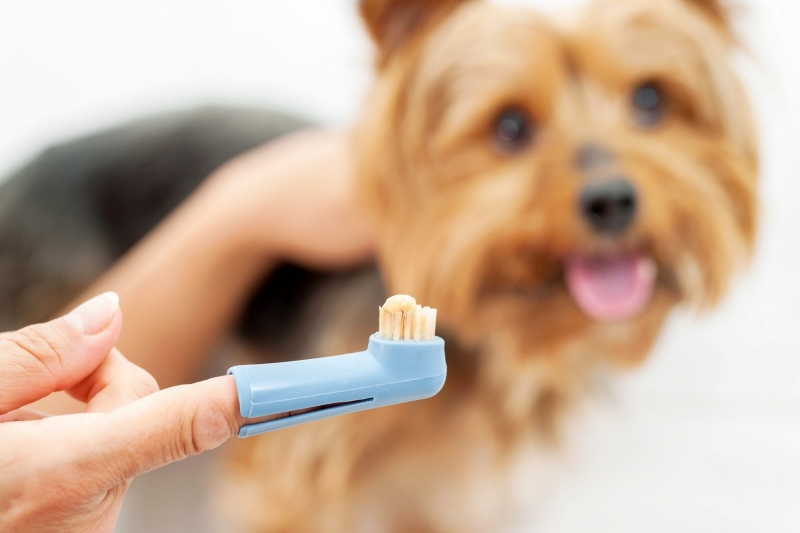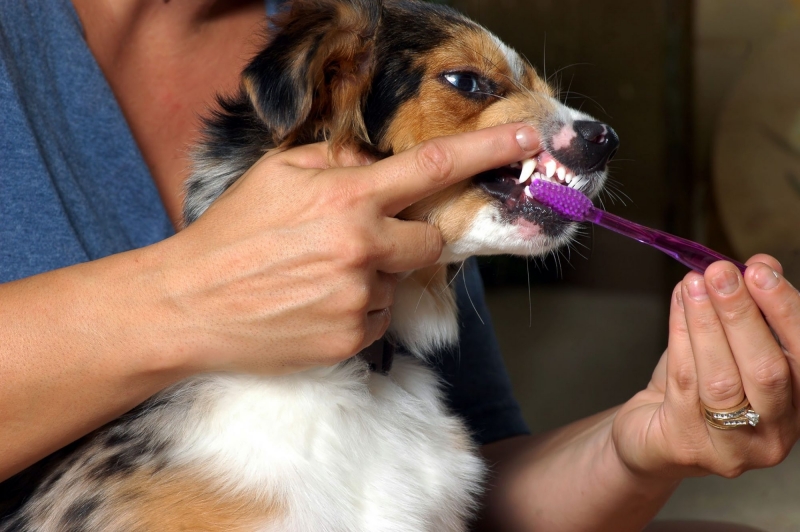Dental care is a top concern for pet owners, as a dog’s oral health reflects their overall well-being. Similar to humans, dogs require proper tooth brushing for healthy and strong teeth.
However, due to various reasons, many pet owners still overlook dental hygiene for their furry companions. Dental diseases, especially periodontal disease, are common among pets, but they can be prevented and treated effectively. We can prevent dental diseases by maintaining a balanced diet and brushing our dog’s teeth daily. Additionally, choosing appropriate chew toys for them is crucial.
Selecting the right time to start brushing your dog’s teeth is also vital. It’s best to begin when they are young (ideally around 8 weeks old) or after they have received dental care at the veterinarian’s office.
1. Let the dog get used to your hand

Massaging your dog’s lips, teeth, and gums is a great way to promote oral health and relaxation. To ensure your dog stays comfortable, find a cozy spot where they can relax undisturbed. Using your fingers, gently massage the lips for about a minute, applying slow and gentle pressure. You can do this massage twice a day.
Next, proceed to massage the teeth and gums in the same manner. It may take your dog a few weeks to become accustomed to this massage and feel comfortable with it. Be patient and gentle, allowing your furry friend time to adjust to the sensation.
Massaging your dog’s lips, teeth, and gums not only helps improve circulation and promote healthy gums but also allows you to monitor for any signs of dental issues such as tartar buildup or gum inflammation. Regular massages can also help desensitize your dog to dental care procedures, making tooth brushing and oral examinations easier in the long run.
Incorporate these massages into your dog’s grooming routine to maintain their oral health and strengthen the bond between you and your furry companion. Remember to always use gentle motions and provide plenty of praise and rewards to make the experience positive for your dog. With patience and consistency, you can help keep your dog’s mouth healthy and their tail wagging with joy.
2. Choose a fixed time of day to brush your dog’s teeth
This practice will contribute to making daily tooth brushing a positive habit for your pet. Brushing your pet’s teeth daily, especially before walks or training sessions, can help your pet genuinely look forward to this activity.
Take some time (it could be a few days) for both you and your dog to get accustomed to this routine. After brushing their teeth, be sure to praise and reward them for their cooperation and patience. This positive reinforcement helps reinforce the behavior and makes the experience more enjoyable for your pet.
By incorporating tooth brushing into your pet’s daily routine and providing positive reinforcement, you can help them develop good dental habits and maintain their oral health for years to come. Remember, consistency and patience are key to success, so stick with it and celebrate the progress your pet makes along the way.
3. Get your dog used to the brush and whitening cream
Once your dog has become familiar with your hand, you can start introducing them to the taste of toothpaste by placing a pea-sized amount on your finger and allowing them to taste it. This helps you determine if your dog likes the flavor of the toothpaste and helps them get used to it.
When your dog is comfortable with the toothpaste, apply some to your finger and begin rubbing it along the length of their teeth and gums. These are the initial steps of the oral hygiene process.
Next, let your dog have a good look at the toothbrush. Then, apply some toothpaste to the brush and gently place it in your dog’s mouth. It’s important not to brush their teeth right away; instead, let them get used to having the brush in their mouth.
By gradually introducing your dog to the toothpaste, toothbrush, and brushing process, you can help them feel more comfortable and cooperative during dental care routines. Remember to be patient and offer plenty of praise and rewards to make the experience positive and enjoyable for your furry friend.
4. Brush one front tooth
Once your dog has become accustomed to brushing with the toothbrush, start by brushing a few teeth at a time, typically starting with the canine teeth as they are the longest.
Brushing a few teeth at a time allows your dog to gradually acclimate to the sensation of the brush and the brushing process. Focus on the outer surfaces of the teeth, using gentle, circular motions to effectively remove plaque and debris. Be sure to praise and reward your dog for their cooperation and patience during the brushing session.
Over time, you can gradually increase the number of teeth brushed during each session until you’re able to brush the entire mouth comfortably. Remember to use a pet-safe toothpaste and a soft-bristled toothbrush designed specifically for dogs to ensure a safe and effective brushing experience. With patience and consistency, you can help your dog maintain good oral hygiene and enjoy a healthy smile for years to come.
5. Brush the outer surface of your teeth

Brush the teeth and gums in a vertical motion, and you’ll only spend less than 30 seconds brushing your pet’s teeth. Don’t try to brush the entire mouth right away.
If your dog only allows you to brush the outer surface of the upper teeth, don’t be discouraged because that’s still the most important part in preventing periodontal disease. Be persistent because eventually, your dog will allow you to brush all of their teeth.
6. Brushing the Inner Surface of the Teeth
Once your dog is comfortable with tooth brushing on the outer surface, you can begin brushing the inner surface of the teeth. Gently help your dog open their mouth, and start brushing from the easiest positions and gradually move to more challenging areas.
After brushing your dog’s teeth, refrain from using mouthwash for them. Moreover, avoid scolding or threatening your dog to make them think tooth brushing is a chore.
7. Effective Toothbrushing Techniques for Dogs
You can feed your dog dry kibble instead of canned food or soft treats. Dry kibble helps reduce plaque buildup on the teeth.
Chewing bones and toys helps stimulate saliva production in dogs. This helps prevent plaque buildup on the teeth and also helps reduce stress. However, this is only a short-term solution and cannot replace tooth brushing.
While at-home dental care is beneficial, dogs still need professional dental cleanings at the veterinary clinic like humans. It’s advisable to take your furry friend to the vet for a dental check-up every 6 months.